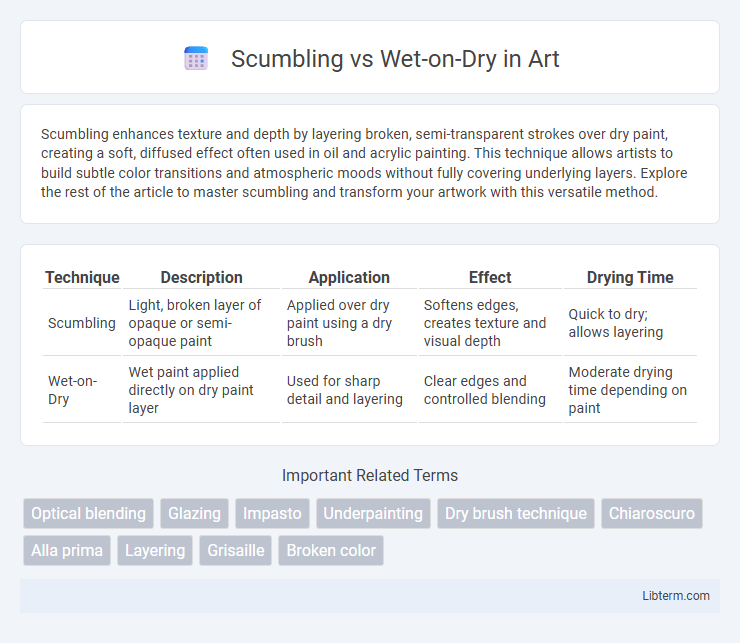Scumbling enhances texture and depth by layering broken, semi-transparent strokes over dry paint, creating a soft, diffused effect often used in oil and acrylic painting. This technique allows artists to build subtle color transitions and atmospheric moods without fully covering underlying layers. Explore the rest of the article to master scumbling and transform your artwork with this versatile method.
Table of Comparison
| Technique | Description | Application | Effect | Drying Time |
|---|---|---|---|---|
| Scumbling | Light, broken layer of opaque or semi-opaque paint | Applied over dry paint using a dry brush | Softens edges, creates texture and visual depth | Quick to dry; allows layering |
| Wet-on-Dry | Wet paint applied directly on dry paint layer | Used for sharp detail and layering | Clear edges and controlled blending | Moderate drying time depending on paint |
Understanding Scumbling: A Brief Overview
Scumbling involves applying a thin, semi-opaque layer of paint over a dried paint layer to create texture and soften edges, enhancing depth in artwork. This technique contrasts with Wet-on-Dry, where wet paint is applied directly onto a dry surface to maintain precise details and crisp lines. Mastery of scumbling enables artists to manipulate light and atmosphere effectively by blending colors subtly without losing underlying forms.
What is Wet-on-Dry Technique?
Wet-on-dry technique involves applying wet paint onto a dry surface, allowing for greater control and precise edges in artwork. This method is ideal for layering colors without blending, preserving the distinctness of each stroke. Artists often use wet-on-dry to create detailed textures and sharp contrasts in acrylics or watercolor paintings.
Key Differences Between Scumbling and Wet-on-Dry
Scumbling involves applying a thin, semi-opaque layer of paint over a dried layer to create texture and soften colors, while wet-on-dry refers to painting wet paint directly onto a dry surface for sharp, defined edges. Scumbling is ideal for achieving subtle tonal variations and atmospheric effects, whereas wet-on-dry technique maintains color integrity and produces distinct shapes. The key difference lies in scumbling's emphasis on texture and blending versus wet-on-dry's focus on precision and color separation.
Tools and Materials for Scumbling
Scumbling requires dry, stiff-bristle brushes or sponges to create a broken, textured effect by applying thin, semi-opaque layers of paint over a dry surface. Artists often use oil or acrylic paints with a palette knife or fan brushes to achieve the soft, hazy strokes characteristic of scumbling. Proper surface preparation, such as a rough or matte ground, enhances the paint's adherence and the technique's visual depth.
Tools and Materials for Wet-on-Dry
Wet-on-dry painting techniques require tools such as stiff-bristled brushes, palette knives, and detail brushes to create precise, sharp edges and textured effects. Artists typically use thicker paints like acrylics or oils applied over a dry layer, enhancing color vibrancy and control. Suitable surfaces include primed canvases or boards that support layering without paint blending.
Step-by-Step Scumbling Techniques
Scumbling techniques involve applying a thin, opaque layer of lighter, dry paint over a darker, dry surface to create texture and depth, achieved by using a dry brush with minimal paint and light, circular motions. Begin by selecting a stiff-bristled brush, load it with a small amount of paint, and remove excess paint on a palette or cloth to maintain a dry application. Gradually build up layers with controlled, semi-transparent strokes, allowing each layer to dry before adding the next to enhance the overall luminosity and surface complexity.
Mastering Wet-on-Dry Application
Mastering wet-on-dry application involves applying paint onto a fully dried layer, allowing precise control over edges and detailed textures in artwork. This technique contrasts with scumbling, where a thin, semi-opaque layer is brushed over dry paint to create a soft, broken color effect. Achieving mastery in wet-on-dry painting enhances clarity, sharpness, and depth in compositions by preserving distinct shapes and lines.
Best Practices: When to Use Scumbling vs Wet-on-Dry
Scumbling is best used for adding texture and softening edges by applying a thin, semi-transparent layer of paint over a dried base, ideal for creating atmospheric effects and depth in landscapes or portraits. Wet-on-dry technique excels when sharp details and clear edges are necessary, allowing precise control and layering of colors without blending. Artists choose scumbling to enhance luminosity and subtle transitions, while wet-on-dry ensures crispness and definition, making each technique suitable for distinct stages or styles in painting processes.
Common Mistakes and How to Avoid Them
Scumbling often results in unintended harsh textures or muddy colors when paint is applied too thickly or without proper drying beneath, while wet-on-dry techniques can lead to harsh edges and lack of blending if the underlying layer is completely dry and rigid. Common mistakes include overloading the brush in scumbling and neglecting to soften edges in wet-on-dry, which disrupt the intended visual harmony. To avoid these pitfalls, painters should practice controlled brush pressure and maintain slight moisture in paint layers to ensure smooth transitions and the desired textural effect.
Choosing the Right Technique for Your Artwork
Scumbling creates texture by applying a thin, broken layer of lighter or darker paint over a dry base, ideal for adding depth and subtle highlights. Wet-on-dry involves painting over thoroughly dried layers, providing sharp edges and precise details, perfect for controlled effects in landscapes or portraits. Choosing between scumbling and wet-on-dry depends on desired texture, blending control, and the emotional tone sought in your artwork.
Scumbling Infographic

 libterm.com
libterm.com